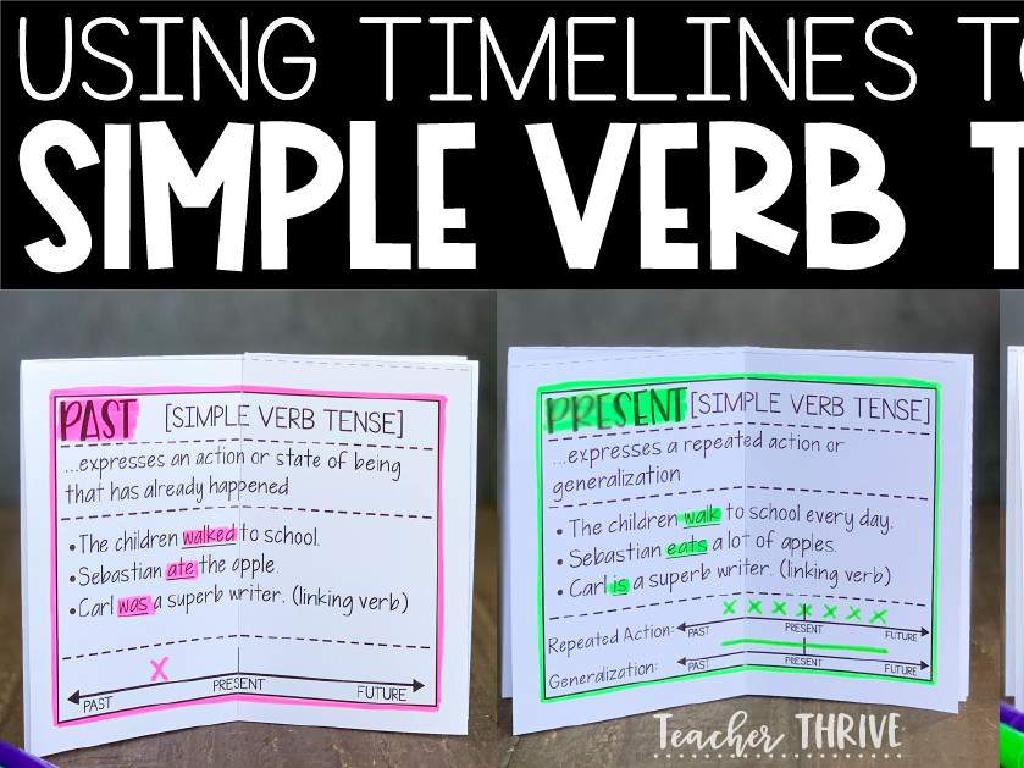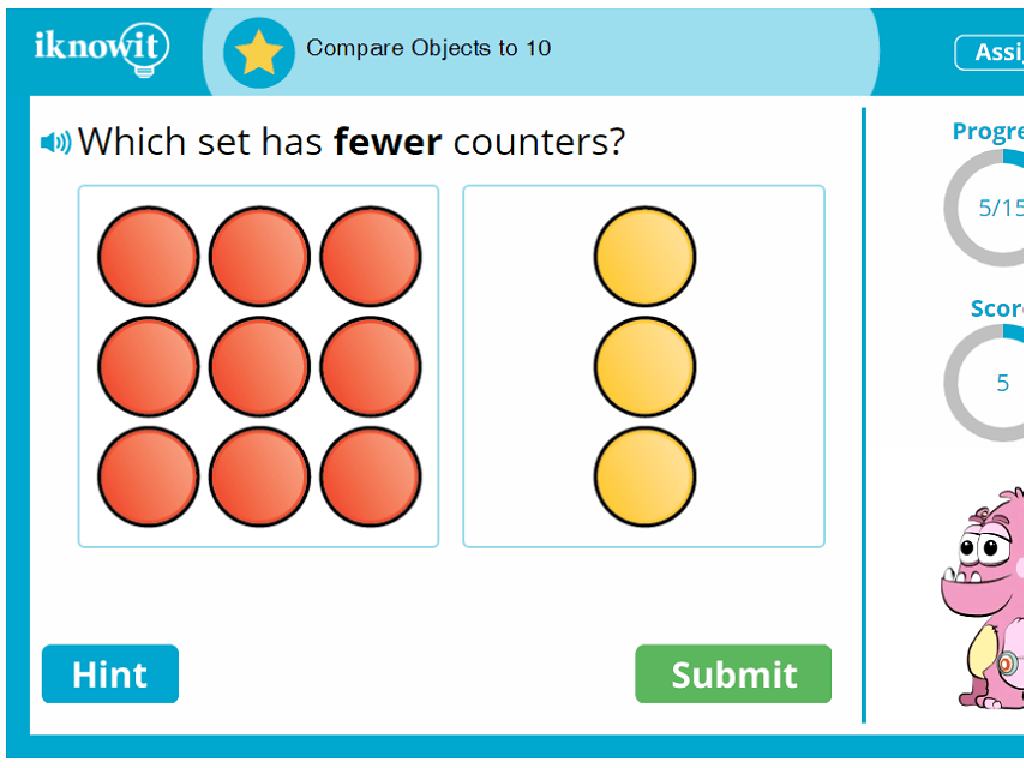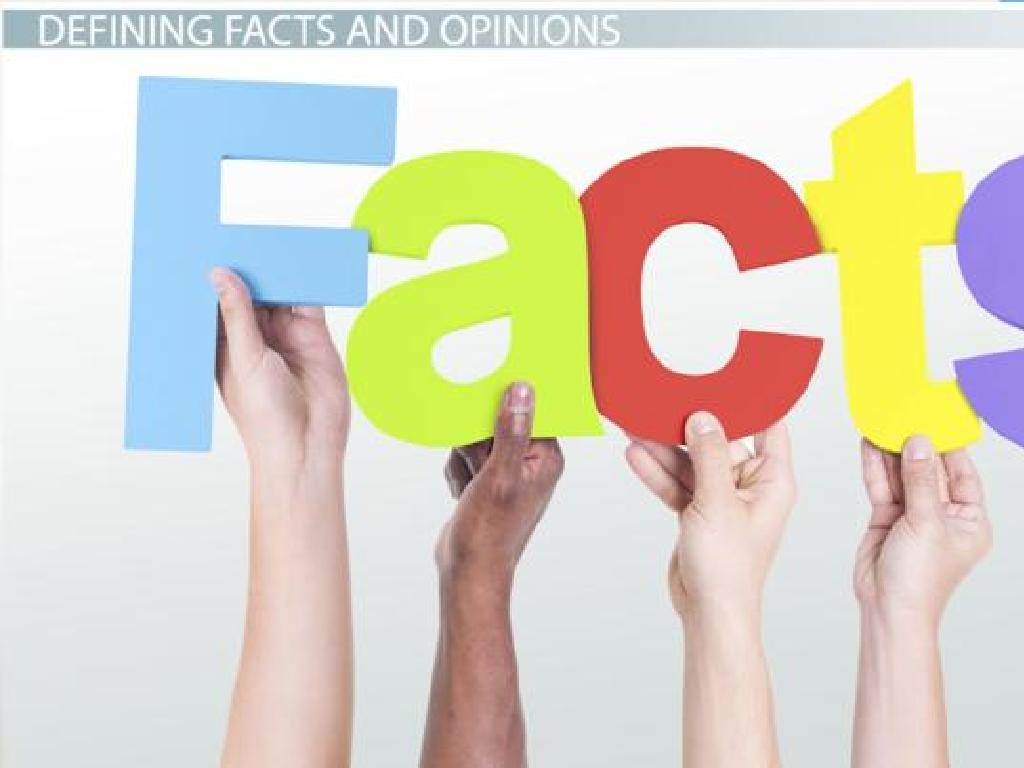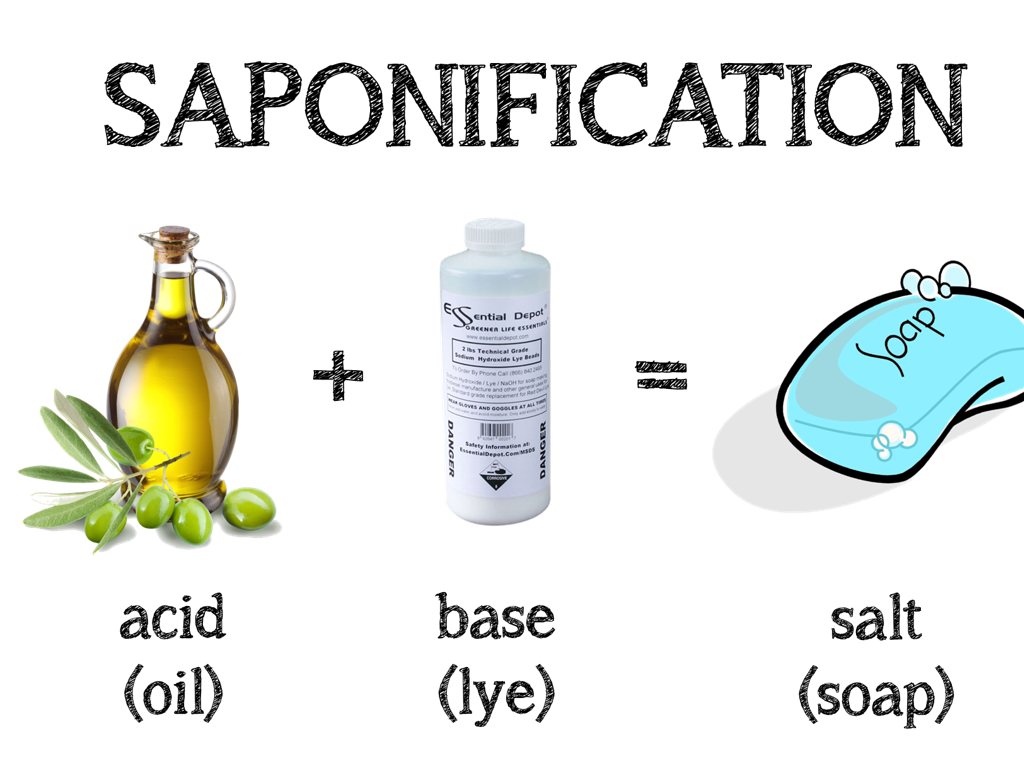Identify Common And Proper Nouns
Subject: Language arts
Grade: Third grade
Topic: Nouns
Please LOG IN to download the presentation. Access is available to registered users only.
View More Content
Today’s Adventure: Common and Proper Nouns!
– What are nouns?
– Nouns are words for people, places, things, or ideas
– Discovering nouns around us
– Look around, every name you see is a noun!
– Common vs. Proper nouns
– Common nouns are general names, proper nouns are specific
– Noun Hunt Activity
|
Begin the lesson by explaining that nouns are the building blocks of language, representing people, places, things, or ideas. Use classroom objects, names of students, and items visible outside the window as examples of nouns. Then, differentiate between common nouns (general names like ‘city’, ‘dog’) and proper nouns (specific names like ‘New York’, ‘Buddy’). To reinforce the concept, engage the students in a ‘Noun Hunt’ activity where they identify and categorize nouns in the classroom or from a story. This interactive approach helps solidify their understanding of common and proper nouns in a fun and engaging way.
Understanding Common Nouns
– Common nouns: general names
– Names for any person, place, or thing
– Examples: ‘city’, ‘movie’, ‘river’
– ‘city’ refers to any city, not a specific one
– Not capitalized usually
– Capitalize at sentence start
– Only capitalize ‘river’ if it starts a sentence
|
This slide introduces the concept of common nouns to third-grade students. Common nouns are words that refer to general items rather than specific ones and are not capitalized unless they begin a sentence. Use everyday objects in the classroom to give examples of common nouns, and ask students to identify common nouns from a list or within a sentence. Emphasize the difference between common and proper nouns, ensuring students understand that common nouns are more general. For homework, students could find common nouns in their favorite books or around their home to reinforce the lesson.
Understanding Proper Nouns
– Specific names are proper nouns
– Names that identify unique entities
– Examples: ‘Michael’, ‘Golden Gate Bridge’
– ‘Michael’ is a person, ‘Mars’ is a planet
– Always begin with a capital letter
– This is a key rule in English grammar
|
This slide introduces the concept of proper nouns to third-grade students. Proper nouns are the specific names given to unique entities such as people, places, or things, and they are always capitalized. Use examples that are relatable to the students, like their own names, names of familiar landmarks, or planets in the solar system. Emphasize the importance of capitalization as it helps to distinguish proper nouns from common nouns. Encourage students to practice by identifying proper nouns in sentences and ensuring they start with a capital letter. This foundational grammar concept will aid them in their writing and reading comprehension.
Common vs. Proper Nouns
– ‘country’ vs. ‘India’
– ‘company’ vs. ‘Nike’
– Spot the differences
– ‘country’ is general, but ‘India’ is specific
– Specific names are Proper Nouns
– Proper nouns name specific people, places, or things
|
This slide is aimed at helping third-grade students distinguish between common nouns and proper nouns. Start by presenting the words ‘country’ and ‘India’, and ‘company’ and ‘Nike’. Explain that ‘country’ and ‘company’ are common nouns because they refer to a general item, place, or idea. In contrast, ‘India’ and ‘Nike’ are proper nouns because they refer to specific names of a particular country and company. Encourage the students to think of more examples and to understand that proper nouns always start with a capital letter, which is a key indicator of their specificity. This foundational understanding will help them in writing and reading comprehension.
Practice Time: Common vs. Proper Nouns
– Identify nouns in sentences
– Distinguish common and proper nouns
– Common nouns are general names, proper nouns are specific names
– Partner work: Find classroom examples
– Look around and pick items, decide if their names are common or proper
– Share your findings with the class
|
This slide is for a class activity focused on identifying and differentiating between common and proper nouns. Students will work in pairs to look at sentences and categorize the nouns they find. They will also observe their surroundings in the classroom to find real-life examples of both types of nouns. For instance, ‘desk’ is a common noun, while ‘Mrs. Smith’ is a proper noun. After the activity, pairs will share their examples with the class, fostering a collaborative learning environment. The teacher should circulate the room, providing guidance and ensuring that each pair understands the concept. Possible activities include identifying nouns in a favorite book, writing sentences with both common and proper nouns, or creating a classroom noun scavenger hunt.
Let’s Play: Common or Proper Noun Sort!
– Understand Common vs. Proper Nouns
– Common nouns are general names, proper nouns are specific.
– Receive cards with different nouns
– Each card has one noun, like ‘dog’ or ‘Sarah’.
– Sort nouns into Common or Proper groups
– Place ‘dog’ in Common and ‘Sarah’ in Proper group.
– Ready, set, go! Who will sort correctly first?
|
This interactive game is designed to help students differentiate between common and proper nouns. Before starting, explain that common nouns are general names for people, places, or things (e.g., ‘city’, ‘teacher’) and proper nouns name specific ones (e.g., ‘New York’, ‘Mrs. Smith’). Hand out cards with nouns and have students sort them into two piles: Common and Proper. This activity will reinforce their understanding through practice. To make it more engaging, turn it into a friendly competition to see who can sort their cards correctly the fastest. After the game, review the sorted piles as a class to ensure understanding and correct any misconceptions.
Create Your Own Nouns Activity
– Draw a place or person
– Write sentences with nouns
– Describe what you drew using nouns
– Use common and proper nouns
– Remember, a proper noun names a specific one
– Share with the class!
|
This activity is designed to help students practice identifying and using common and proper nouns in context. Students will start by drawing a picture of a person or a place, which will serve as a visual aid for their sentences. They should then write sentences about their drawing, making sure to include both common nouns (like ‘city’, ‘dog’, ‘teacher’) and proper nouns (like ‘New York’, ‘Buddy’, ‘Mrs. Smith’). Encourage creativity and ensure they understand that proper nouns are specific and are always capitalized. After they have written their sentences, students will have the opportunity to share their work with the class, which will help reinforce their understanding and allow for peer learning.
Class Activity: Noun Hunt
– Become a Noun Detective
– Find 10 common nouns in class
– Objects like ‘desk’, ‘chair’, ‘book’
– Spot 5 proper nouns around
– Names like ‘Sarah’, ‘Texas’, ‘Monday’
– Who will be the first to find all?
|
This activity is designed to help students apply their knowledge of common and proper nouns in a fun and interactive way. Before starting, review what common and proper nouns are. Common nouns are general names for a person, place, or thing, like ‘dog’ or ‘school’. Proper nouns are specific names, like ‘Mr. Smith’ or ‘Eiffel Tower’, and they always start with a capital letter. Encourage students to look around the classroom and write down the nouns they find. For example, ‘window’, ‘teacher’, ‘pencil’ for common nouns, and ‘Miss Johnson’, ‘June’, ‘Friday’ for proper nouns. Provide a worksheet for them to record their findings. After the hunt, discuss as a class what everyone found and correct any misconceptions. This will reinforce their understanding of the difference between common and proper nouns.
Review and Reflect: Common vs. Proper Nouns
– Recap on common and proper nouns
– Common nouns are general names, proper nouns are specific names.
– Importance of noun differences
– Knowing the difference helps us communicate clearly.
– Share a memorable lesson point
– Maybe how to capitalize proper nouns, or examples like ‘dog’ vs. ‘Fido’.
–
|
As we wrap up today’s lesson, let’s take a moment to review and reflect on what we’ve learned about common and proper nouns. It’s crucial for students to understand that common nouns are general names for things, while proper nouns are specific names that always start with a capital letter. Understanding the difference is important for proper grammar and clear communication. Ask students to share one thing they’ll remember from today’s lesson, which could be the rule of capitalization or examples that helped them grasp the concept. This reflection helps reinforce their learning and allows you to assess their understanding.





